Browse Primary Sources
Locate primary sources, including images, objects, media, and texts. Annotations by scholars contextualize sources.
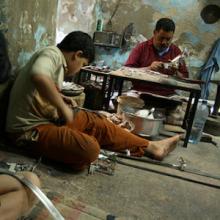
Child in Ramdan Lantern Family Workshop
In the weeks and months before the start of Ramadan, the ninth lunar month when Muslims fast, traditional workshops like the one on Ahmad Maher Street in the medieval quarter of Cairo, turn recycled tin cans into glittering lanterns.
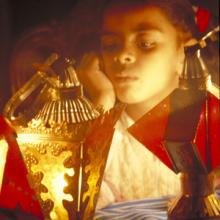
Egyptian Ramadan Lanterns
The photograph at the top shows two children gazing into the soft light of a fanoos [fan-NOOS], or traditional Ramadan lantern. In the photograph below, Ramadan lanterns are hung outside a shop in a section of medieval Cairo. As far as is known, the tradition originated in Egypt, perhaps as long ago as pharaonic times, when it may have announced the Nile flood.
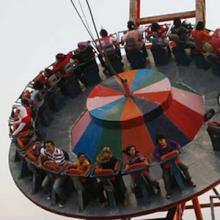
Eid Holiday Amusements
On the two major celebrations of the Islamic lunar calendar—Eid al-Fitr and Eid al-Adha—public festivities in cities and towns across Muslim regions of Asia, Africa, and elsewhere include rides of various kinds. In the photograph at top from Jenin, in the West Bank city of Palestine, children and young adults ride a whirling disk brought in for the occasion.
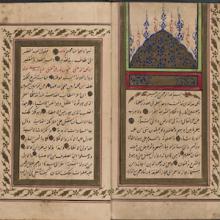
Ijazahs (Diploma)
During the medieval period, gifted children who successfully memorized the entire Qur'an left their home at the age of about 12-14 to travel to a nearby town and eventually around the Middle East to study with renowned academic authorities to hear historical, religious, philosophical, and legal texts.

Education in a Warzone
In some regions of the Middle East today, conflict impacts students' daily educational experience. Since the 2003 invasion of Iraq, militants have targeted educational establishments, thousands of academics have fled the country, and up to 70% of schools have been closed. People in this region maintain their high regard for education in the face of adversity, as this podcast relates.
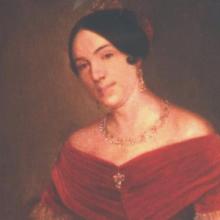
Manuelita
Manuela Rosas (1817-1898), the daughter of Juan Manuel de Rosas, emerged as one of the most important political symbols of the early 19th century. In 1838, her mother, Doña Encarcación, died, and her father proclaimed his daughter as the nation's first lady. At the age of 21, Manuela was thrust into a new political role. By all accounts, she was very popular.
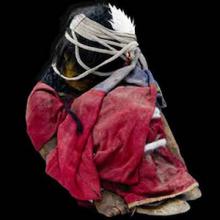
Mummified Inca Child Sacrifices
The top photograph shows the mummified remains of the 15-year-old Inca child, known as the "Llullaillaco Maiden," who was sacrificed with two other children, a boy of seven years old, shown in the photograph below, and a six-year-old girl, whose mummy had been struck by lightning and was charred. The children had walked or been brought to the top of Mt.
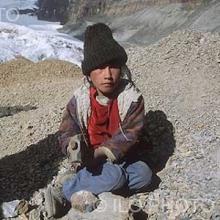
Child Labor at La Rinconada
This photograph is of a boy between 6-10 years of age who works in the La Rinconada gold mine in the mountainous region of Peru. La Rinconada is the highest gold mine in the world, 5,500 meters above sea level in the Andes, and under a glacier, and its camp is populated by about 20,000 people who live under economically exploitative and impoverished conditions.
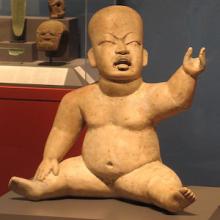
Olmec Ceramic Baby Figurine
This baby figurine of a pudgy toddler is one of many similar examples of ceramic sculptures of infants belonging to an ancient Mesoamerican ceramic tradition that flourished during the first millennium B.C.E. The figurines are hollow and often nearly life-sized (about 25 to 35 cm, or 10 – 14 inches high), made of white kaolin clay, or ordinary clay covered with white slip.
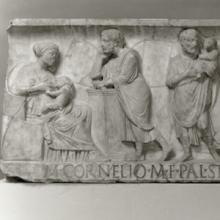
M. Cornelius Statius
Death is part of every society, but the rituals and objects surrounding death have varied across centuries and continents. They can often reveal many things about the role of children and families within a culture, from the nature of grieving to representations of childhood, from artistic preferences to child rearing norms.
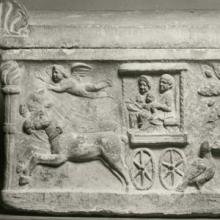
Child’s Life Course
Death is part of every society, but the rituals and objects surrounding death have varied across centuries and continents. They can often reveal many things about the role of children and families within a culture, from the nature of grieving to representations of childhood, from artistic preferences to child rearing norms.

Gin Lane (1751)
This is one of the best-known prints by the famous artist, William Hogarth. He designed it to support the British government's attempt to regulate the price and popularity of drinking gin (known as Geneva) in the Gin Act of 1751. The print is accompanied by the following verse:
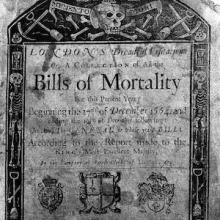
London's Bill of Mortality
During the great outbreak of bubonic plague or black death in the hot summer of 1665 in London, special bills of mortality were issued that listed causes of death. By mid-July over a thousand deaths a week were reported on handbills that were stuck up in public places to warn people that the plague was growing. The rich fled the city but the poor did not have that option and died in droves.
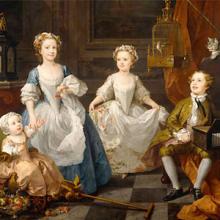
The Graham Children
This beautiful life-size painting of four children is by William Hogarth, who also specialized in engravings such as Gin Lane. It was commissioned by Daniel Graham, a rich apothecary (pharmacist) to the royal family and to Chelsea Hospital in London. It shows Daniel's three children by his second wife, Mary Crisp, and Mary's daughter, Henrietta, by her first marriage.
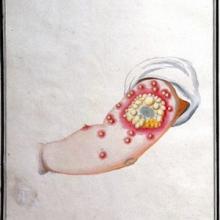
An Inquiry into the Causes and Effects of the Variolae Vaccinae
Edward Jenner (1749-1823) was a physician in rural Gloucestershire. Like Lady Mary Wortley Montagu he learnt of a widely known folk remedy to protect against smallpox. Smallpox cases were increasing in the 18th century and had a mortality rate of 40%. At least 30% of those who survived were left horribly scarred. Smallpox was a disease of children and youth in particular.
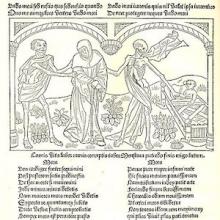
The Dance of the Dead
Children are not frequent subjects of medieval art, but the figure of the child does occur in a medieval artistic and literary form known as the Danse macabre or Dance of the Dead.

Will-making among the general populace of Bologna during 1348
The graph displays the number of wills by gender made each month in the city and countryside of Bologna during 1348 that were copied into the city notarial registers, known as the Libri Memoriali. The graph shows that during the first half of the year there are more female than male testators, which is unusual for medieval Italy.
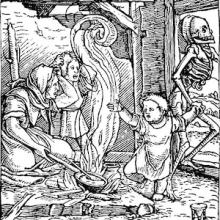
The Dance of Death
Children are not frequent subjects of medieval art, but the figure of the child does occur in a medieval artistic and literary form known as the Danse macabre or Dance of the Dead.
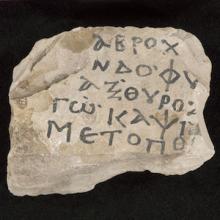
Ostracon
In Greek and Roman times children and adults often wrote on ostraca (that is, pieces of broken pottery and limestone flakes). They were costless and convenient writing materials. On this flat limestone piece a student practiced letters of the alphabet. S/He did not do so at random but tried to reproduce a nonsensical verse that contained all the letters.

The Red Shoes
Folktales have been used for generations to teach moral tales to children. They have shifted over time depending upon the generation and location of the tale but remain part of the childhood experience for many young people. "The Red Shoes" published by Hans Christian Andersen in 1845 is a quintessential European folktale.